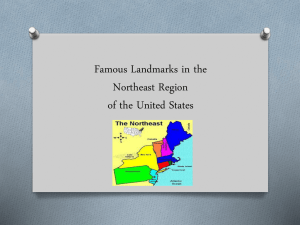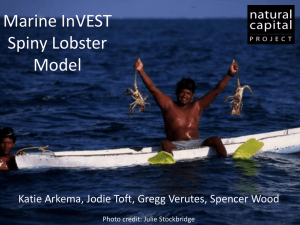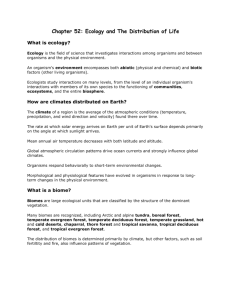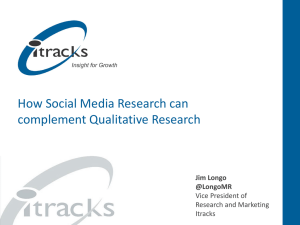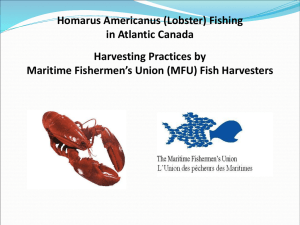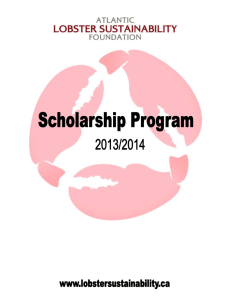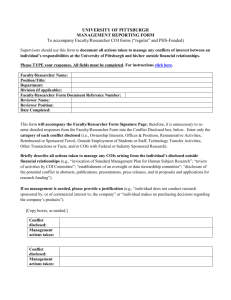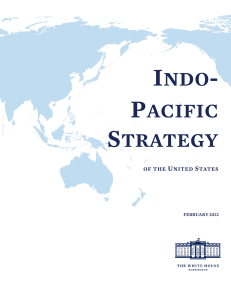jbi12689-sup-0001-AppendixS1-S3
advertisement
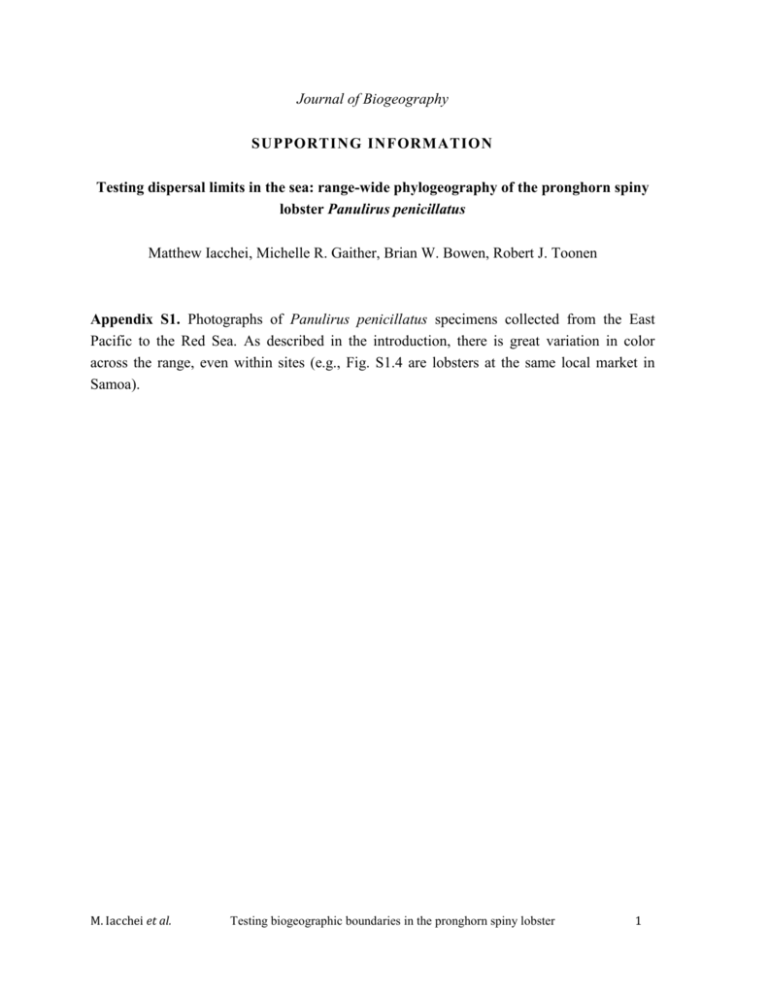
Journal of Biogeography SUPPORTING INFORMATION Testing dispersal limits in the sea: range-wide phylogeography of the pronghorn spiny lobster Panulirus penicillatus Matthew Iacchei, Michelle R. Gaither, Brian W. Bowen, Robert J. Toonen Appendix S1. Photographs of Panulirus penicillatus specimens collected from the East Pacific to the Red Sea. As described in the introduction, there is great variation in color across the range, even within sites (e.g., Fig. S1.4 are lobsters at the same local market in Samoa). M. Iacchei et al. Testing biogeographic boundaries in the pronghorn spiny lobster 1 Figure S1.1 Photographs of a Panulirus penicillatus specimen collected from the East Pacific – Revillagigedo Islands. This is the only East Pacific sample we obtained a photograph for, and this lobster was photographed at night, making it difficult to see the redder coloration of the body compared to the rest of the range. There are also different spotting patterns at the base of the tail on the dorsal side near the uropods, not seen in this photo. Photo credit: Scott Aalbers. M. Iacchei et al. Testing biogeographic boundaries in the pronghorn spiny lobster 2 Figure S1.2 Photographs of two Panulirus penicillatus specimens collected from the Hawaiian Archipelago. The top lobster has the darker body color and thin, wavy lines on the legs versus the lighter body and thick, white lines on the legs of the lobster in the bottom photo. Photo credit: Matthew Iacchei (top) and Joseph O’Malley (bottom). M. Iacchei et al. Testing biogeographic boundaries in the pronghorn spiny lobster 3 Figure S1.3 Photograph of a Panulirus penicillatus specimen collected in Fiji. Photo credit: Posa Skelton. M. Iacchei et al. Testing biogeographic boundaries in the pronghorn spiny lobster 4 Figure S1.4 Photograph of three Panulirus penicillatus specimens collected at a fish market in Samoa. Note the variation in body color and the width and color of the leg stripes even within one sample. Photo credit: John Fitzpatrick. M. Iacchei et al. Testing biogeographic boundaries in the pronghorn spiny lobster 5 Figure S1.5 Photograph of two Panulirus penicillatus specimens collected in the Western Indian Ocean on Zanzibar. Both of these lobsters were frozen in a local fisher’s freezer when sampled and photographed. Photo credit: Michelle R. Gaither and Shelley Jones. M. Iacchei et al. Testing biogeographic boundaries in the pronghorn spiny lobster 6 Figure S1.6 Photograph of Panulirus penicillatus specimens collected at Dream Beach, Jeddah, Saudi Arabia in the Red Sea. The specimens in the photos correspond to the following Genbank sequences: Specimen #RS2473: (12S–KT954806; 16S–KT954848; COI–KT954888). Specimen #RS2474: (12S–KT954807; 16S–KT954849; COI– KT954889. Photo credit: Tane Sinclair-Taylor. M. Iacchei et al. Testing biogeographic boundaries in the pronghorn spiny lobster 7 Appendix S2 Details of phylogenetic analyses of Panulirus penicillatus including methods and parameter choices, PARTITIONFINDER results, BEAST results, the specimens from public databases that were included in all analyses, the specimens used to make the multi-locus phylogeny, and the condensed maximum likelihood tree for all of the P. penicillatus COI sequences. Sample Collection, DNA Extraction, PCR, Sequencing Tissue samples that were preserved in salt-saturated 20% dimethyl sulfoxide buffer followed the protocols of Gaither et al. (2011); however, we found no difference in amplfication for P. penicillatus between EtOH and DMSO-preserved samples. Three sets of primers were used in this study. Species-specific primers for cytochrome c oxidase subunit I (COI) (Iacchei et al., 2014) were designed internal to the LCO1490/HCO2198 primer set of Folmer et al. (1994), and were used to resolve a 460 bp fragment of COI for all individuals used in the study. For a subset of individuals (Table S2.4), we also resolved 522bp of 12S mtDNA using the primer set in Podsiadlowski and Bartolomaeus (2005) and a 440bp region of 16S mtDNA using the Palumbi et al. (1991) primers (see Table S2.4 for a list of all individuals and which individuals were resolved at which mtDNA regions). BEAST To estimate the time to most recent common ancestor (TMRCA), we used the Bayesian MCMC approach implemented in BEAST. We kept molecular and mutation models unlinked across loci and we employed a relaxed uncorrelated lognormal clock for 12S and 16S. We used a coalescent tree prior assuming expansion growth. Following the results of PARTITIONFINDER (Table S2.1), we used the TN93 model of mutation (plus gamma for COI and 12S and invariant sites for 16S) and ran simulations for 20 million generations with sampling every 1000 generations. Ten independent runs were computed to ensure convergence. Effective sample sizes (ESS) were calculated for all model parameters to ensure adequate mixing. Tree files were combined using LOGCOMBINER 1.7.5 after 10% burn-in and resampled every 4000 trees for a total of 50,000 trees. Maximum likelihood tree (RAXML) Following the results of PARTITIONFINDER, the GTR+G model of nucleotide substitution was implemented for all DNA segments using a random starting tree and four discrete rate categories. All model parameters were estimated by RAXML and partitions were assigned according to gene region. We estimated support for individual clades in the tree with 1000 bootstrap replicates. M. Iacchei et al. Testing biogeographic boundaries in the pronghorn spiny lobster 8 Phylogeographic analyses To test for hierarchical population genetic structure, an analysis of molecular variance (AMOVA) was performed in ARLEQUIN using 100,000 permutations. Pairwise ΦST comparisons among all locations with N > 5 were also tested for statistical significance using a permutation analysis with 100,000 permutations. We controlled for false discovery rate as recommended by Benjamini et al. (2006). Following the PARTITIONFINDER results (Table S2.1), we used the TrN (Tamura & Nei, 1993) sequence evolution model with a Ti/Tv ratio of 7.273 and gamma parameter of 1.550 for ARLEQUIN analyses. In accordance with other crustacean studies, we used Kimura’s two-parameter distance model (K2P; Kimura, 1980) to calculate genetic distance between mitochondrial lineages to be able to compare our results with other crustacean studies. Mantel tests were conducted to test for isolation-by-distance (IBD) among populations in the Western and Central Pacific. Mantel tests were performed using multiple combinations in full factorial: all sites, all sites except the Sino-Japanese Province, ΦST including negative values, ΦST with negative values converted to zeroes; log of ΦST, and log of geographic distance. Each Mantel test was conducted with 10,000 iterations using the ISOLATION-BY-DISTANCE WEB SERVICE 3.23 (Jensen et al., 2005). Table S2.1 PARTITIONFINDER results for each of the three sequence regions (Marker) using the specified number of base pairs (Bp). Results include the recommended model of sequence evolution for each region and analysis program (BEAST, RAXML, All Models - for all possible models available in the program). Marker Bp All Models COI 460 TrN+G TrN+G GTR+G 12S 522 TrN+G TrN+G GTR+G 16S 440 TrN+I TrN+I GTR+G M. Iacchei et al. BEAST RAXML Testing biogeographic boundaries in the pronghorn spiny lobster 9 Table S2.2 BEAST results for the estimated time to most recent common ancestor (TMRCA) and 95% highest posterior density (95% HPD) in parentheses for: 1) all samples included in the tree (TMRCA All); 2) just the P. penicillatus samples with no outgroups (TMRCA All PP); 3) the Indo Pacific P. penicillatus samples (TMRCA IP); 4) the East Pacific P. penicillatus samples (TMRCA EP); 5) the Red Sea P. penicillatus samples (TMRCA RS); 6) the Red Sea P. penicillatus samples combined with the Indo-Pacific P. penicillatus samples (TMRCA RS+IP). Details on the BEAST runs are provided in the methods section of Appendix S2. In addition to running the program using a coalescent tree prior assuming expansion growth, we also ran BEAST using an exponential growth model and it made little difference. Parameter Tree prior COI clock TMRCA All TMRCA All PP TMRCA IP TMRCA EP TMRCA Red Sea TMRCA RS + IP M. Iacchei et al. Prior/Result (95% HPD) Expansion growth 1.39% 6.892 (3.48, 10.82) 1.519 (0.890, 2.306) 0.299 (0.172, 0.461) 0.218 (0.091, 0.404) 0.256 (0.103, 0.468) 0.707 (0.416, 1.095) Testing biogeographic boundaries in the pronghorn spiny lobster 10 Table S2.3 Specimens included in this study from Panulirus penicillatus COI sequences previously catalogued in GenBank. All sequences were trimmed to our COI sequencing region (internal to the LCO1490 and HCO2198 primers in Folmer et al. (1994)), and checked for ambiguities prior to analysis. Only sequences from adult individuals with a known sampling location were utilized. Sequences for population-level analyses are organized by site (Sample Site), and include the number of individuals used for each site (N), and the GenBank sequence identification number for each individual (GenBank Sequence ID). Sample Site N Chesterfield Islands 5 Fiji 5 Galapagos Islands 10 India Indonesia M. Iacchei et al. 2 4 GenBank Sequence ID AB610683 AB610684 AB610685 AB610686 AB610687 AB610678 AB610679 AB610680 AB610681 AB610682 AB610699 AB610700 AB610701 AB610702 AB610703 AB610704 AB610705 AB610706 AB610707 AB576722 JN418940 JQ229881 AB576713 AB576714 AB576715 AB576716 Sample Site N Japan 15 New Caledonia 6 Palau Torres Strait Tuamotu Archipelago 1 1 6 Testing biogeographic boundaries in the pronghorn spiny lobster GenBank Sequence ID AB576698 AB576699 AB576700 AB576701 AB576702 AB576703 AB576704 AB576705 AB576706 AB576707 AB576708 AB576709 AB576710 AB576711 AB576712 AB610688 AB610689 AB610690 AB610691 AB610692 AB610693 AF339468 Pan1504.1 AB610669 AB610670 AB610671 AB610672 AB610673 AB610674 11 Table S2.4 Specimens used in the Panulirus penicillatus phylogeny. Included are all East Pacific and Red Sea specimens, and a stratified random subset of specimens from the Indo-Pacific to cover a broad geographical scope. Listed here are the region, collection location, and GenBank Accession numbers for each specimen resolved for each of the three different mitochondrial DNA loci included in the phylogeny: 12S, 16S, and COI. Species Region Collection Location P. penicillatus P. penicillatus P. penicillatus P. penicillatus P. penicillatus P. penicillatus P. penicillatus P. penicillatus P. penicillatus P. penicillatus P. penicillatus P. penicillatus P. penicillatus P. penicillatus P. penicillatus P. penicillatus P. penicillatus P. penicillatus P. penicillatus P. penicillatus P. penicillatus P. penicillatus P. penicillatus P. penicillatus P. penicillatus P. penicillatus P. penicillatus East Pacific East Pacific East Pacific East Pacific East Pacific East Pacific East Pacific East Pacific East Pacific East Pacific East Pacific East Pacific Indo-Pacific Indo-Pacific Indo-Pacific Indo-Pacific Indo-Pacific Indo-Pacific Indo-Pacific Indo-Pacific Indo-Pacific Indo-Pacific Indo-Pacific Indo-Pacific Indo-Pacific Indo-Pacific Indo-Pacific P. penicillatus P. penicillatus P. penicillatus P. penicillatus P. penicillatus Indo-Pacific Indo-Pacific Indo-Pacific Indo-Pacific Indo-Pacific Clarion Island Clarion Island Clarion Island Clarion Island Clarion Island Clarion Island Clarion Island Clarion Island Clarion Island Clarion Island Clarion Island Galapagos Islands Hawai'i Island Hawai'i Island Hawai'i Island Fiji Fiji French Frigate Shoals Lisianski Island Maro Reef Marquesas Marquesas Marquesas Palau Palau Taiwan Taiwan Torres Straight, Australia Wake Island Wake Island Wake Island Western Samoa M. Iacchei et al. GenBank Accession Numbers 12S 16S COI KT954773 KT954812 KT954855 KT954774 KT954813 KT954856 KT954775 KT954814 KT954857 KT954776 KT954815 KT954858 KT954777 KT954816 KT954859 KT954778 KT954817 KT954860 KT954779 KT954818 KT954861 KT954780 KT954819 KT954862 KT954781 KT954820 KT954863 KT954782 KT954821 KT954864 KT954783 KT954822 KT954865 KT954823 KT954866 KT954784 KT954824 KT954867 KT954785 KT954825 KT954868 KT954786 KT954826 KT954869 KT954787 KT954827 KT954870 KT954788 KT954828 KT954871 KT954829 KT954872 KT954830 KT954873 KT954789 KT954831 KT954874 KT954790 KT954832 KT954875 KT954791 KT954833 KT954876 KT954792 KT954834 KT954877 KT954793 KT954835 KT954794 KT954836 KT954795 KT954837 KT954796 KT954838 KT954878 KT954797 KT954798 KT954799 KT954800 KT954801 KT954839 KT954840 KT954841 KT954842 KT954843 Testing biogeographic boundaries in the pronghorn spiny lobster KT954879 KT954880 KT954881 KT954882 KT954883 12 Species Region Collection Location P. penicillatus P. penicillatus P. penicillatus P. penicillatus P. penicillatus P. penicillatus P. penicillatus P. penicillatus P. penicillatus P. penicillatus P. penicillatus Indo-Pacific Indo-Pacific Indo-Pacific Indo-Pacific Red Sea Red Sea Red Sea Red Sea Red Sea Red Sea Red Sea Western Samoa Western Samoa Zanzibar Zanzibar Saudi Arabia Saudi Arabia Saudi Arabia Saudi Arabia Saudi Arabia Saudi Arabia Saudi Arabia Outgroups P. echinatus P. echinatus P. echinatus P. echinatus M. Iacchei et al. GenBank Accession Numbers 12S 16S COI KT954802 KT954844 KT954884 KT954803 KT954845 KT954885 KT954804 KT954846 KT954886 KT954805 KT954847 KT954887 KT954806 KT954848 KT954888 KT954807 KT954849 KT954889 KT954808 KT954850 KT954890 KT954851 KT954891 KT954809 KT954852 KT954892 KT954810 KT954853 KT954893 KT954811 KT954854 KT954894 AF339454 AF337965 JQ412159 AB248090 Testing biogeographic boundaries in the pronghorn spiny lobster 13 Figure S2.7 Condensed Maximum Likelihood tree for 829 COI sequences of Panulirus penicillatus. Panulirus echinatus is included as an outgroup. Data were analysed using MEGA 6 (Tamura et al., 2013). Based on the PARTITIONFINDER results, the Tamura and Nei model (gamma distributed) was employed, with bootstrap (BS) values calculated based on 100 replicates. Only nodes with BS values of >75 are labelled. M. Iacchei et al. Testing biogeographic boundaries in the pronghorn spiny lobster 14 REFERENCES Benjamini, Y., Krieger, A.M. & Yekutiele, D. (2006) Adaptive linear step-up procedures that control the false discovery rate. Biometrika, 93, 491–507. Folmer, O., Black, M., Hoeh, W., Lutz, R. & Vrijenhoek, R. (1994) DNA primers for amplification of mitochondrial cytochrome c oxidase subunit I from diverse metazoan invertebrates. Molecular Marine Biology and Biotechnology, 3, 294–299. Gaither, M.R., Szabó, Z., Crepeau, M., Bird, C.E. & Toonen, R.J. (2011) Preservation of corals in salt-saturated DMSO buffer is superior to ethanol for PCR experiments. Coral Reefs, 30, 329–333. Jensen, J.L., Bohonak, A.J. & Kelley, S.T. (2005) Isolation by distance, web service. BMC Genetics, 6, 13. v.3.23 http://ibdws.sdsu.edu/ Kimura, M. (1980) A simple method for estimating evolutionary rate of base substitutions through comparative studies of nucleotide sequences. Journal of Molecular Evolution, 16,111-120. Palumbi, S.R., Martin, A., Romano, S., McMillan, W.O., Stice, L. & Grabowski, G. (1991). A simple fool’s guide to PCR, v2.0. Special Publication of the University of Hawaii Department of Zoology and Kewalo Marine Laboratory, pp. 1–23. Podsiadlowski, L. & Bartolomaeus, T. (2005) Organization of the mitochondrial genome of mantis shrimp Pseudosquilla ciliate (Crustacea: Stomatopoda). Marine Biotechnology, 7, 618-624. Tamura, K. & Nei, M. (1993) Estimation of the number of nucleotide substitutions in the control region of mitochondrial DNA in humans and chimpanzees. Molecular Biology and Evolution, 10, 512–526. M. Iacchei et al. Testing biogeographic boundaries in the pronghorn spiny lobster 15 Appendix S3 Acknowledgements We greatly appreciate the assistance of the following individuals in collecting specimens, as without their assistance, the breadth of this project would never have been possible: Jesse Hapdei, Tammy Mae Summers, Mark Michael, Scott Aalbers, Kacy Lafferty, Chugey Sepulveda, Shelley Jones, Joseph DiBattista, Mark Priest, Gustav Paulay, J.P. Hobbs, Michael Berumen, Tin Yam Chan, Posa Skelton, John Fitzpatrick, Eric Tong, Zoltán Szabó , Cecile Fauvelot and colleagues, Hal Koike, Paolo Usseglio, Calvin Gerry, Maria, and Danny at the Seychelles Fishing Authority (SFA), Steve Karl, Jill Zamzow, Sam Kahn, Meaghan Sundberg, Palmyra Crew: Kydd “Captain Chaos” Pollock, Dan “Danimal” Wagner, Zachary “ Bohar” Caldwell, Ginny Kim, Captain Steve, Will, Wendy, Jen, and Bobbi; Robert Moffitt, Kona Division of Aquatic Resources (especially Brent Carman and Kosta Stamoulis), Derek Skillings, Jon Puritz, Carl Meyer, Woody Woodward, Krista Woodward and Captain Woody’s Snorkel Charters, Terry Lilley, Jon Barretto, Geoff Walker, Mac Poepoe, Joseph O’Malley, Jeff Eble, James Ashe, George Thompson and Fathom Five Divers, Terry Buholm, Patrick Conley, Lawrie Provost, Tanya Beirne and Big Island Spearguns, Kevin Schneider, Lisa Nelson, Megan Lamson, Bob Carrol, Skippy Hau, Victoria Martocci, Eric Stein and the crew of Extended Horizons, Greg Concepcion, Nyssa Silbiger, Megan Donahue, Toby Daly-Engel, Illiana Baums, Michael Stat, Megan Huggett, Jen Salerno, Jon Dale, Melanie Hutchinson, Elizabeth Keenan, Molly Timmers, Scott Godwin, Kelvin Gorospe, Ben Wainwright, Kevin Flanagan, Kim Tice, Miguel Castrance, Tim Clark, Kim Weersing, Matt Craig, Anela Choy, Matt Ross, Megan Ross, Jon Yeh, Heather Leba, Dana Crompton, Mike Musyl, Derek Smith, Anne Mooney, Kelly Gleason, Will Love, Josh Copus, Iria Fernández-Silva, and Chris Bird. We thank the University of Hawai‘i Dive Safety Program (Dave Pence, Kevin Flanagan, Keoki Stender, Tina Tsubota, Maria Laamang), the scientists and crew of the NOAA ship Hi‘ialakai, NWHI Monument Staff, the Hawai‘i Institute of Marine Biology office and fiscal staff for all of their logistical support and facilitation of this project. We thank the Papahānaumokuākea Marine National Monument, US Fish and Wildlife Services, and Hawai‘i Division of Aquatic Resources (DAR) for coordinating research activities and permitting. We are grateful to Erik Conklin at TNC and Amanda Meyer at the US Fish and Wildlife Service Palmyra for making collections there possible. Collections in Saudi Arabia were conducted under the general auspices of the King Abdullah University of Science and Technology (KAUST) with the assistance of the KAUST Reef Ecology Lab. The Red Sea collections were funded by the KAUST Office of Competitive Research Funds (OCRF) under Award No. CRG-1-2012-BER-002 and baseline research funds to Michael Berumen. Many thanks to Alexander Shiarella, Kaleonani Hurley, and Richard Coleman who assisted with lab work. Also, thanks to Shaobin Hou and the University of Hawaii’s Advanced Studies of Genomics, Proteomics, and Bioinformatics staff for their assistance with DNA sequencing, as well as Sarah Daley, Rajesh Shrestha, Mindy Mizobe, and Amy Eggers and the HIMB EPSCoR Core Genetics Facility. Many thanks to the ToBo Lab for M. Iacchei et al. Testing biogeographic boundaries in the pronghorn spiny lobster 16 assistance both in the lab and for thoughtful contributions to this paper, especially Chris Bird, Kimberly Conklin, Richard Coleman, Joseph DiBattista, Iria Fernandez-Silva, Zac Forsman, Ingrid Knapp, Derek Skillings, Marieke Sudek, and Jon Whitney. This paper was greatly improved thanks to comments from Jonatha Giddens, Charles Birkeland, Megan Donahue, and Alison Rieser. The views expressed herein are those of the authors, and may not reflect the views of the EPA, NOAA, or their sub-agencies. M. Iacchei et al. Testing biogeographic boundaries in the pronghorn spiny lobster 17

